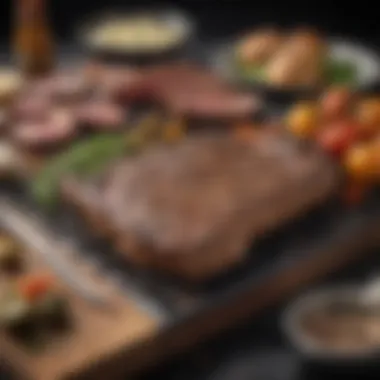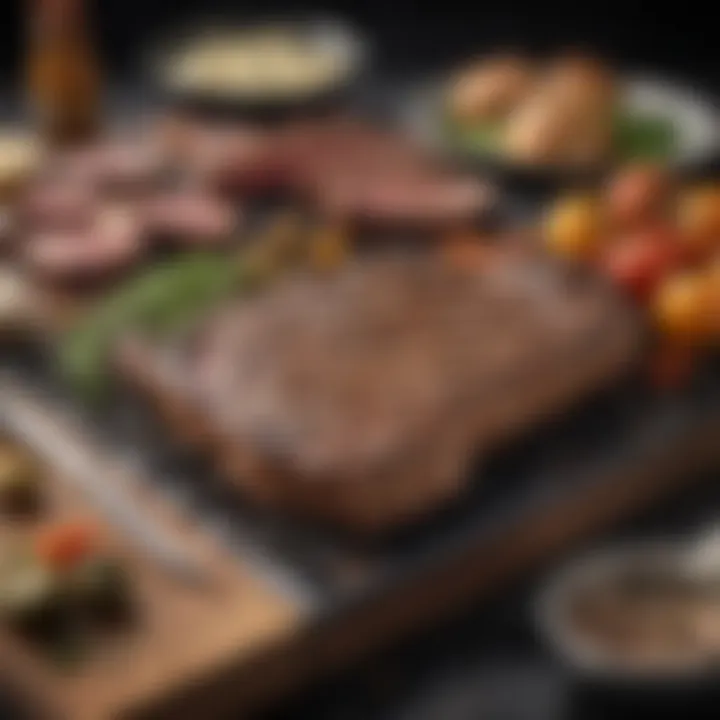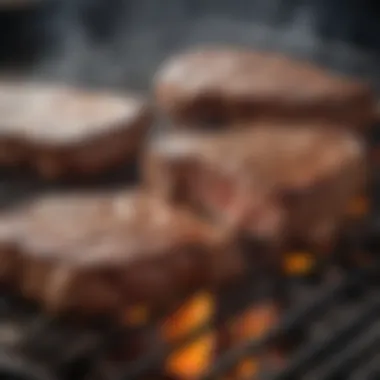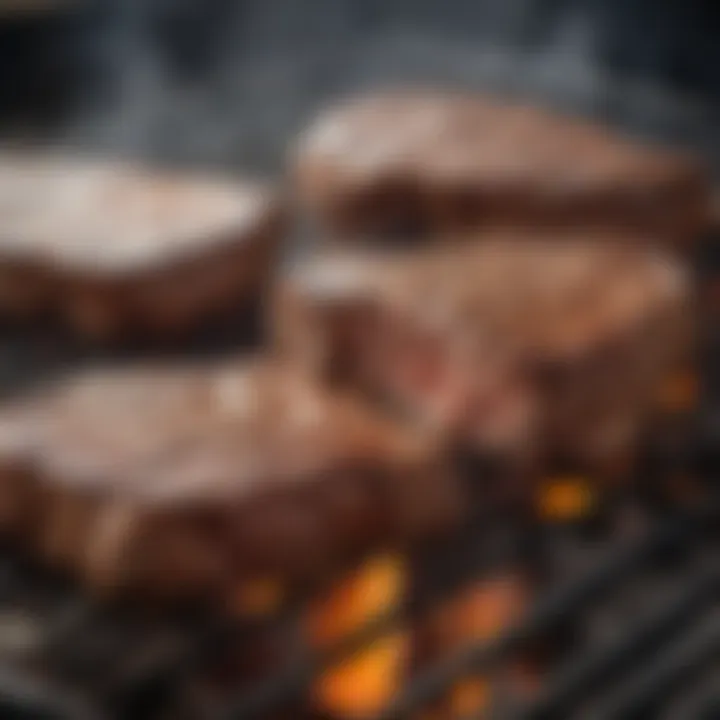Mastering the Art of Grilling T-Bone Steak


Intro
Grilling a T-bone steak represents both an art and a science. Understanding its unique structure, which includes a tenderloin on one side and a strip steak on the other, can elevate the grilling experience. This cut is rich in flavor and is favored by many steak lovers. In this guide, we will explore the nuances of grilling T-bone steak, starting from preparation and ending with serving suggestions. Mastering this process will not only enhance your culinary skills but also deepen your appreciation for this classic dish.
Choosing the right tools and seasoning is pivotal. The grill's heat, the choice of wood or charcoal, and even the timing of cooking all contribute to the final outcome. With a step-by-step approach, we aim to provide comprehensive insights that both novice and experienced cooks can appreciate.
Preparation is critical. Knowing how to select and store ingredients ensures that you start with the best foundation possible. By understanding the techniques and variations in cooking T-bone steak, you set yourself up for success. Let's delve deeper into this delicious endeavor.
Understanding the T-Bone Steak
Grilling a T-bone steak is not just about cooking; it is about appreciating one of the most revered cuts of beef. Understanding what makes T-bone steak unique will inform your choices in preparation and cooking techniques. This section will cover its anatomy, flavor profile, and how to choose the right cut. Each aspect plays a crucial role in ensuring a memorable grilling experience, whether you are a seasoned chef or a novice.
Anatomy of the T-Bone
The T-bone steak features a T-shaped bone, which divides two popular cuts of meat: the tenderloin and the strip loin. The tenderloin, known for its buttery texture and rich taste, is smaller but prized for its tenderness. In contrast, the strip loin offers a heartier flavor with more marbling, which adds juiciness.
This unique anatomy brings distinct flavors and textures to your plate. When cooked correctly, the T-bone can satisfy a range of palates. Knowing the anatomy helps in understanding doneness levels and selecting cooking methods that best suit each part of the steak.
Flavor Profile and Texture
The flavor of a T-bone steak is complex. The combination of lean and marbled meat allows for a delightful contrast. The rich, beefy flavor of the strip loin tends to be more pronounced, while the tenderloin adds a soft, melt-in-your-mouth quality.
Texture varies primarily due to the fat distribution. The marbling in the strip loin contributes to a juicier bite, enhancing the overall eating experience. When preparing, it is essential to consider these flavors and textures, as they inform the choice of seasoning and cooking technique.
Choosing the Right Cut
Selecting the perfect T-bone is vital for a successful grilling session. Look for steaks with a prominent T-shaped bone and visible marbling. The meat should be bright red with a little bit of fat cap. The thickness also matters; aim for a cut that is at least an inch thick to avoid overcooking and ensure an even cook.
In addition to appearance, source your steak from reputable butchers or farmers who can provide information on the beef’s origin. Quality beef often leads to better flavor. Take time and choose wisely; the right cut can elevate your grilling experience significantly.
Essential Grilling Equipment
Understanding the right grilling equipment is crucial when preparing to grill a T-bone steak. The equipment you choose not only affects the cooking time but also influences the quality and flavor of the beef. Selecting suitable tools and devices enables you to achieve that perfect sear and desired doneness, which is essential for a satisfying steak experience.
Types of Grills
Gas Grills
Gas grills are known for their convenience and control. They provide immediate heat, allowing for quick cooking and easy temperature adjustments. This is particularly valuable when grilling T-bone steaks, as precise heat management is important for creating a well-seared crust.
A key characteristic of gas grills is their ease of use. Unlike charcoal, they don’t require much preparation time. With just a turn of the knob, the grill ignites, making it a popular choice for many barbecue enthusiasts. However, the flavor can be different compared to charcoal. Some might argue that gas lacks the smoky flavor traditional grilling methods provide. Yet, using wood chips can enhance the taste if you desire that smokiness.
Charcoal Grills
Charcoal grills are favored for their ability to impart a distinctive flavor to meats. The high heat generated by burning charcoal can create an excellent sear on T-bone steaks, sealing in the juices and enhancing the flavor profile.
What sets charcoal grills apart is the unique charred taste they offer. This can appeal to many steak lovers seeking authenticity in their grilled meals. While they may take longer to heat up compared to gas grills, they are often perceived as more rewarding. On the downside, managing temperature can be trickier, requiring skill and patience.
Electric Grills
Electric grills serve as a versatile option for those who may not have access to outdoor grilling spaces. They can be used indoors, which broadens grilling opportunities significantly. Their design typically allows for precise temperature control, making cooking easier.
A key feature of electric grills is their safety. They do not produce open flames, reducing the risk of flare-ups. Consequently, they can be a good option for beginners. However, they may not provide the same depth of flavor as charcoal or gas, as they often lack that real smoke essence in the grilling process.
Grilling Tools and Accessories
Grill Brush
A grill brush is essential for maintaining cleanliness and performance of the grill grates. Before starting to grill, it is crucial to ensure that the grates are free from residue. Cleaning helps prevent sticking and ensures even cooking.
The bristles of a good grill brush are typically designed to tackle stubborn debris effectively. A well-cleaned grill produces better-tasting food, as leftover burnt particles can negatively affect flavor. However, be cautious with brush materials, as some can wear out or shed bristles, presenting a safety concern.
Meat Thermometer
Using a meat thermometer is vital for accurately determining the doneness of your T-bone steak. Without it, one might risk overcooking or undercooking the meat, which can affect the overall dining experience.
The key aspect of a meat thermometer is its ability to provide instant results, allowing you to monitor the steak's internal temperature precisely. This tool enables you to achieve your preferred doneness level consistently. While some may rely on the cut's appearance alone, a thermometer removes guesswork, ensuring food safety and quality.
Grill Tongs


Having a reliable set of grill tongs is as important as the meat itself. Tongs allow for easy flipping and maneuvering of the steak on the grill without piercing the meat, which can cause juices to escape.
The characteristic feature of grill tongs is their length. Longer handles keep hands safe from heat while allowing you to handle hot food effectively. A good pair of tongs should provide a firm grip, giving you better control over the steak. However, be wary of tongs that are too flimsy, as they might make handling difficult.
> In Summary: Investing in quality grilling equipment and tools enables a more enjoyable and successful grill experience. Each type of grill and tool contributes uniquely, aiding in achieving that ideal T-bone steak. Make a choice that aligns with your grilling style and preferences.
Preparation Techniques
Preparation techniques play a pivotal role in the overall success of grilling a T-bone steak. The way you prepare the steak can significantly influence its flavor, tenderness, and juiciness. Proper preparation ensures that the meat absorbs flavors, maintains its texture, and cooks evenly. Each technique serves as a foundation for achieving the desired result on the grill. In this section, we will explore various methods and their importance in preparing a T-bone steak for the grill.
Thawing the Steak
Before grilling, it is essential to ensure that your T-bone steak is properly thawed. Cooking a frozen or partially frozen steak can lead to uneven cooking, where the outside may cook faster than the inside. This can result in a less enjoyable texture. For best results, you should thaw the steak in the refrigerator, allowing it to reach an even temperature. This process usually takes about 24 hours. Alternatively, if you are pressed for time, you can use cold water in a sealed bag, changing the water every 30 minutes until thawed. This method is quicker but requires more attention to avoid bacteria growth.
Marinating vs. Dry Rub
When it comes to flavoring your T-bone steak, you'll want to consider whether to marinate or use a dry rub. Marinating involves soaking the meat in a mixture of liquids and spices, which helps to infuse flavors and tenderize the meat. Common ingredients in marinades include olive oil, vinegar, and various spices and herbs. It's advisable to marinate the steak for at least an hour, but longer times can yield better results, ideally up to 24 hours.
On the other hand, a dry rub is a mixture of spices applied directly to the meat's surface before grilling. This technique creates a flavorful crust during cooking. Typical ingredients for dry rubs include salt, pepper, garlic powder, and paprika. A dry rub can be applied shortly before grilling, making it more convenient for quick meals. Each method has its advantages, and choosing between them depends on your flavor preferences, the time available, and the cooking method.
Bringing to Room Temperature
Allowing your T-bone steak to come to room temperature before grilling is a crucial step that often gets overlooked. Steaks taken straight from the refrigerator are cold inside, which can lead to uneven cooking. By leaving the steak out for approximately 30 to 60 minutes prior to cooking, the internal temperature rises slightly. This helps to achieve a more even doneness throughout the steak while also enhancing the Maillard reaction—the browning that gives grilled meat its flavor. However, be cautious not to leave the meat out too long to avoid any food safety issues. It's essential to keep an eye on it, especially on warm days, as bacteria can develop if the meat is left out for too long.
Grilling Techniques
Grilling techniques are the backbone of mastering the art of cooking T-bone steak. Understanding these methods not only elevates the taste of the steak but also influences the texture and overall dining experience. Different techniques can lead to various flavor profiles, and how one manages them can significantly impact the steak's doneness and quality.
Direct Heat vs. Indirect Heat
Direct heat grilling involves placing the steak directly over the flame or heat source. This method is ideal for achieving a perfect sear that locks in juices. It is important for T-bone steaks, as they are thick cuts of meat that benefit from being cooked quickly at a high temperature. The initial char develops a crust that enhances the flavor.
In contrast, indirect heat grilling circulates hot air around the steak, allowing it to cook more slowly and evenly. This method is suitable when cooking larger cuts. The T-bone steak can benefit from indirect heat after achieving a sear, as it will finish cooking without burning the exterior.
Using a combination of both direct and indirect heat can help in achieving a tender and juicy T-bone steak.
Searing the Steak
Searing is a crucial step in the grilling process. It involves cooking the steak at a high temperature for a short amount of time on each side. This caramelizes the meat’s surface, creating a flavorful crust. It's recommended to preheat the grill for at least 15 minutes before adding the steak. When placed on a hot grill, the Maillard reaction occurs, which is essential for flavor enhancement. Avoid moving the steak too much during the process. Allow it to cook undisturbed for a few minutes to achieve a good sear before flipping it.
The ideal time for searing varies, but generally, 3 to 4 minutes per side is a good starting point for T-bone steak. Once seared, you can then move the steak to indirect heat if needed, allowing it to finish cooking while keeping the juices inside.
Managing Grill Temperature
Temperature control is a vital aspect of grilling T-bone steak. A high temperature is necessary for searing, but once the steak is seared, lowering the temperature is crucial to prevent overcooking. The target internal temperature for a medium-rare T-bone is around 130-135°F. A meat thermometer can provide accurate readings.
Additionally, it’s wise to monitor the grill’s actual temperature. If using a charcoal grill, managing the amount of charcoal and airflow can help maintain the desired heat. For gas grills, adjusting the burners can manage high or low temperatures more easily.
By understanding and applying these grilling techniques, you can ensure your T-bone steak turns out flavorful and perfectly cooked.
Seasoning Options
Seasoning is a critical component in grilling T-bone steak, as it significantly enhances the flavor and overall dining experience. The right blend of spices and herbs can highlight the natural beefy taste of the steak. Moreover, proper seasoning can create a crust that adds to the texture. When considering seasoning options, think about both simplicity and complexity. Too much can overwhelm the palate, while too little can make the dish bland. It is essential to choose wisely and embrace a variety of techniques to find what works best for your taste.
Basic Seasoning Techniques
Basic seasoning often involves just a few ingredients, yet it can yield impressive results. The fundamental elements generally include salt and pepper. Using kosher salt is generally preferred because it dissolves well and enhances the meat's flavor without a metallic taste. Ground black pepper adds a layer of warmth and complexity. Apply these seasonings generously on both sides of the steak about 30-60 minutes before grilling. This timing allows the salt to penetrate the meat, enhancing the overall flavor.
- Salt: Enhances flavor and helps retain moisture.
- Black Pepper: Adds depth and subtle heat.
- Timing: Seasoning before grilling aids in flavor absorption.
Herbs and Spices to Enhance Flavor
In addition to salt and pepper, various herbs and spices can intensify the flavor of T-bone steak. Fresh herbs such as rosemary, thyme, and parsley are notable choices. Rosemary imparts a piney and aromatic quality, while thyme adds earthiness. A sprinkle of garlic powder or onion powder can also elevate the overall taste. Experimentation is key in finding the right balance that complements the beef without overshadowing it.
- Rosemary: Offers aromatic notes.
- Thyme: Provides an earthy flavor.
- Garlic Powder: Enriches with a savory essence.
Using a blend of spices can lead to delightful results. However, avoid excessive use of strong spices that may mask the steak's natural flavor.
Experimenting with Marinades


Marinades can introduce complex flavors to the T-bone steak. They often include acidic components such as vinegar or citrus juice, combined with oils and spices. A basic marinade might consist of olive oil, balsamic vinegar, minced garlic, and herbs. This mixture needs to be applied several hours before grilling, or ideally, overnight for best results. The acid helps tenderize the meat while also infusing it with flavor.
Some popular marinade options are:
- Balsamic Marinade: Combines sweetness and acidity.
- Soy Sauce Marinade: Imparts umami flavor.
- Citrus Marinade: Brightness from lemon or lime juice.
When choosing to marinate, be cautious with the timing. A steak left in an acidic marinade for too long can become mushy. Therefore, a range of 2-6 hours is ideal, depending on the intensity of the marinade used.
Achieving Desired Doneness
Achieving the correct doneness is critical in grilling T-bone steak. Many people focus on the steak's cut, seasoning, or grilling temperature, but the level of doneness ultimately dictates the steak's taste, texture, and overall enjoyment. Properly grilled steak reflects the skill of the grill master and contributes to a satisfying meal.
Understanding doneness allows you to cater to different preferences, providing an enjoyable experience for all diners. Variability in cooking time and methods can lead to inconsistencies if doneness is not carefully monitored. As such, having knowledge about doneness levels fosters a deeper appreciation for the preparation process and the unique qualities of the T-bone steak.
Using a Meat Thermometer
A meat thermometer is an invaluable tool for achieving your desired level of doneness. Unlike the tradition of guessing by touch or relying solely on time, using a thermometer ensures accuracy. By inserting the thermometer into the thickest part of the steak, you can monitor the internal temperature as it cooks. This step removes the guesswork, allowing consistent results that align with your personal preferences.
For T-bone steak, the ideal temperature ranges are as follows:
- Rare: 120-125°F (49-52°C)
- Medium Rare: 130-135°F (54-57°C)
- Medium: 140-145°F (60-63°C)
- Medium Well: 150-155°F (65-68°C)
- Well Done: 160°F (71°C) and above
Understanding Doneness Levels
The doneness level of steak plays a significant role in its flavor and texture. Here are the specifics:
Rare
Rare steak retains a cool red center, showcasing the freshness of the meat. It hovers around 120-125°F. This doneness is popular among some steak lovers because it accentuates the natural flavors of high-quality beef. However, it's not suitable for everyone. While it is juicy, others might find it too undercooked.
Medium Rare
Medium rare is a benchmark for steak enthusiasts. With a warm red center (130-135°F), it strikes a balance between tenderness and flavor. This level is preferred by many, and it tends to highlight the beef's juiciness better than any other. It's a good option if you want a steak that is flavorful without being overly chewy.
Medium
Medium steak is cooked to 140-145°F, resulting in a slightly pink center. This doneness offers a compromise between tenderness and flavor. It tends to have a firmer texture but is still moist. Medium steaks appeal to a broad audience due to the more balanced cooking approach, making it a common choice in grilling scenarios.
Medium Well
Cooked to 150-155°F, medium well steak has a hint of pink in the center. This level is often selected by those who prefer their meat to be mostly cooked through. While it retains some moisture, the texture can be firmer and may lose some of the beef's natural flavors. This doneness may alienate purists, but it still suits specific tastes.
Well Done
Well done steak reaches an internal temperature of 160°F and above. It presents a fully cooked, uniform brown more throughout. While some prefer this cooking level for safety reasons, it often sacrifices juiciness and flavor. The meat can become dry and tough, making it less appealing for discerning steak lovers.
"The key to a remarkable T-bone steak experience is understanding and mastering the art of doneness. Each level brings something unique to the plate."
Post-Grilling Techniques
Understanding post-grilling techniques is as important as the grilling process itself. After cooking a T-bone steak, properly managing the steps that follow can significantly impact the final taste and texture. These techniques allow you to maximize the flavors and ensure a pleasurable eating experience. Here are two critical components: resting and carving the steak.
Resting the Steak
Resting the steak is an essential step that should not be overlooked. This process allows the juices inside the meat to redistribute evenly, preventing them from leaking out when you cut into the steak. Cutting the meat immediately after grilling can lead to a dry steak, reducing the overall flavor and enjoyment.
To rest your T-bone steak:
- Cover it loosely with aluminum foil to keep it warm.
- Leave it for at least 5 to 10 minutes. A thicker cut may benefit from a longer rest.
- Use a warm plate to assist in maintaining temperature.
The result of this technique is a tender and juicy steak that is more flavorful than one that is cut straight from the heat. This simple practice has benefits that are well worth the wait.
Carving the T-Bone
Carving the T-bone steak correctly is crucial for presentation and ease of eating. The T-bone consists of two distinct cuts: the tenderloin and the strip loin. Knowing how to carve these sections will enhance the dining experience.
Here is a recommended method for carving:
- Use a sharp knife. A dull knife can crush the meat fibers, leading to a less appealing texture.
- Place the steak on a cutting board, allowing room to work.
- Identify the bone and slice along it. This will help separate the tenderloin from the strip loin.
- Cut against the grain. Look for the direction in which the fibers run and slice perpendicular to them. This method will yield more tender bites.
- Serve slices neatly on a plate, arranged to highlight the different cuts.


Effective carving not only showcases the steak but also enhances the overall dining experience. Proper presentation adds an element of sophistication to your meal.
Serving Suggestions
When it comes to enjoying a T-bone steak, the way it is served can greatly enhance the whole dining experience. Serving suggestions are crucial in creating a complete meal that appeals not only to the palate but also to the aesthetic sense. Good pairing with sides and sauces elevates the steak and complements its rich flavor. Thoughtful serving can turn a simple meal into a memorable dining experience.
Pairing with Sides
Choosing the right sides for T-bone steak can make a significant difference. The ideal accompaniments should balance the steak's robust flavor and texture. Here are some excellent pairing options:
- Grilled Vegetables: Charred bell peppers, zucchini, or asparagus provide a fresh contrast to the savory meat.
- Mashed Potatoes: Creamy mashed potatoes add richness and are an excellent vehicle for any sauces.
- Steamed Broccoli: A light and healthy option, broccoli offers a subtle bitterness that can complement the steak nicely.
- Caesar Salad: The crunchy romaine and creamy dressing provide a refreshing break from the richness of the steak.
- Corn on the Cob: Grilled corn retains a slight sweetness and char that pairs well with the steak.
Recommended Sauces
A good sauce can enhance the T-bone steak without overshadowing its natural flavor. Here are some sauces that work well:
- Chimichurri: This Argentine sauce, made from parsley, garlic, vinegar, and olive oil, adds a zesty freshness and herbal note.
- Béarnaise Sauce: A creamy sauce made from butter, shallots, and tarragon; it provides a luxurious touch.
- Barbecue Sauce: A tangy sauce with a hint of sweetness that pairs well with grilled meats.
- Mushroom Sauce: Savory and earthy, this sauce made from sautéed mushrooms in a cream base is a classic.
- Classic Steak Sauce: Something like A1 can provide a familiar, flavorful kick for many.
Always taste the sauce before serving, adjusting seasoning as necessary to balance flavors.
Using these serving suggestions, you can craft a plate that not only presents beautifully but also enhances the enjoyment of the delicious T-bone steak. This attention to detail can create a dining experience rather than just another meal.
Common Mistakes to Avoid
Grilling a T-bone steak can be a delightful culinary experience. However, making mistakes during the process can lead to less than desirable outcomes. Understanding common pitfalls can enhance your grilling skills and ensure a savory result. Proper attention to these mistakes can elevate your dishes from ordinary to extraordinary. This section will cover two primary areas: overcooking the steak and neglecting grill maintenance. Addressing both concerns will significantly improve your grilling success.
Overcooking the Steak
One of the most common mistakes in grilling a T-bone steak is overcooking. Many tend to cook the steak too long out of fear of serving raw meat. This often results in a dry, tough texture, losing the steak's natural juices. To avoid this, it is crucial to use a meat thermometer to check the internal temperature. The general guidelines for doneness are as follows:
- Rare: 125°F (51°C)
- Medium Rare: 135°F (57°C)
- Medium: 145°F (63°C)
- Medium Well: 150°F (66°C)
- Well Done: 160°F (71°C)
For the best flavor and texture, aim for medium rare. This temperature allows the steak to maintain its moisture while achieving a rich flavor developed during the grilling process. Remember to remove the steak from the grill when it is a few degrees below the desired temperature, as it will continue to cook while resting.
"Overcooking can turn a remarkable cut of meat into something unappealing. Pay attention to timing and temperature."
Neglecting Grill Maintenance
Another common error is failing to maintain the grill properly. Neglected grills can lead to uneven cooking and increased chances of flare-ups. To ensure optimal performance, clean the grill grates thoroughly before and after grilling. Regularly check for any debris or residue that can affect the flavor of the steak.
Regular maintenance also includes oiling the grates to prevent sticking. Use high-smoke point oil like vegetable or canola oil. This helps create a non-stick surface and promotes even heat distribution.
- Inspect the burners for even flame distribution, - Ensure there are adequate fuel levels, - Keep the exterior clean to avoid rust and other damages.
Maintaining the grill not only prolongs its lifespan but also enhances the overall grilling process, ensuring each T-bone steak is perfectly cooked.
In summary, avoiding these common mistakes will significantly advance your grilling technique and enhance the flavor and texture of your T-bone steak.
Final Thoughts
Grilling a T-bone steak is not only about cooking meat; it is an entire experience that encompasses understanding, preparation, and technique. This section wraps up the journey through the art of grilling, emphasizing the significant aspects of the process.
The main importance of this topic lies in its ability to elevate the grilling experience. It is crucial to recognize that each stage of grilling, from selection of the meat to the final moments when the steak is removed from the grill, directly impacts the taste and overall enjoyment of the meal. Mastery comes from practice, but it also requires a mindful approach.
One of the key benefits of following this guide is the confidence it instills in even novice grillers. By embracing the nuances of grilling methods and techniques, individuals can turn a simple meal into a standout culinary event. This guide provides specific steps and insights that not only enhance grilling skills but also encourages appreciation for the cooking process itself.
Considerations when concluding a grilling session include:
- Reflecting on the experience and learning from each grill session.
- Experimenting with flavors and approaches to find personal preferences.
- Sharing the final product with others to enhance the communal aspect of cooking.
Embracing the Process
Embracing the process of grilling is essential for crafting memorable T-bone steaks. This means enjoying every moment, from the moment you choose the cut to the time the steak rests after grilling. Each step adds value to the experience.
Patience is vital. Allowing the steak to rest before cutting into it permits juices to redistribute, ultimately enhancing flavor and tenderness. Taking the time to prepare, season, and understand the grill’s temperature also enhances the final product. The intention should be to appreciate not just the eating, but the act of creating delicious food.
Continuing Culinary Exploration
Continuing culinary exploration in the world of grilling can unlock new flavors and techniques. After mastering the T-bone steak, consider exploring other cuts of meat or different grilling styles. This venture may include experimenting with:
- Different marinades and spices to develop unique taste profiles.
- Various grill types, such as pellet or smoker grills, to expand cooking methods.
- Seasonal ingredients that can be paired with steak for a fresh twist.
Engaging in conversations about grilling skills on platforms like Reddit or joining groups on Facebook can enhance knowledge and provide new ideas. Culinary blogs and resources, such as Wikipedia and Britannica, often offer insights into techniques used by professionals, further aiding in personal development.
"Grilling is a continuous journey where every cook offers a lesson that shapes future expertise."
Taking these steps ensures that the practice of grilling T-bone steaks can persist and diversify long after the first success. This journey of culinary growth will make both grilling and gatherings more enjoyable.







